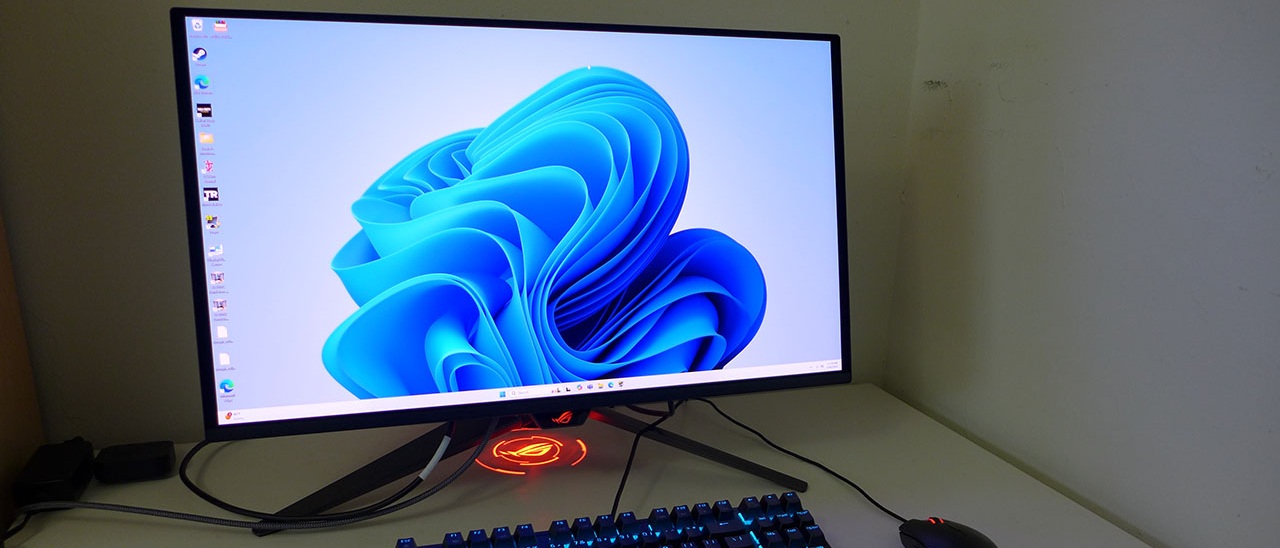Why you can trust Tom's Hardware
To read about our monitor tests in-depth, please check out Display Testing Explained: How We Test PC Monitors. We cover brightness and contrast testing on page two.
Uncalibrated – Maximum Backlight Level
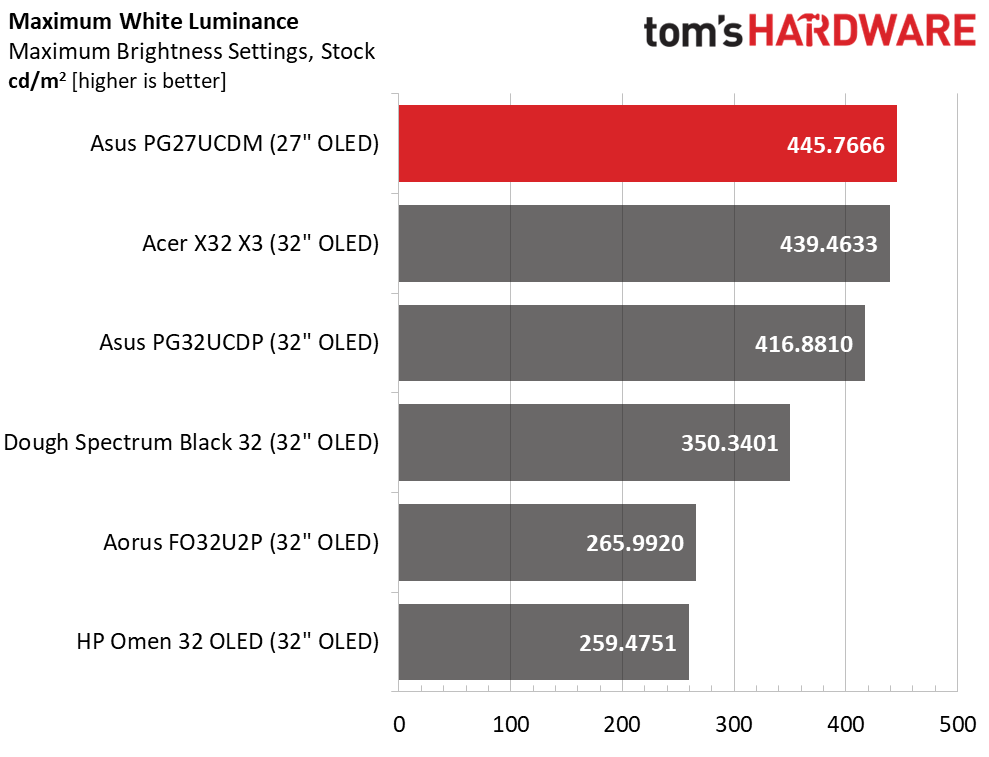

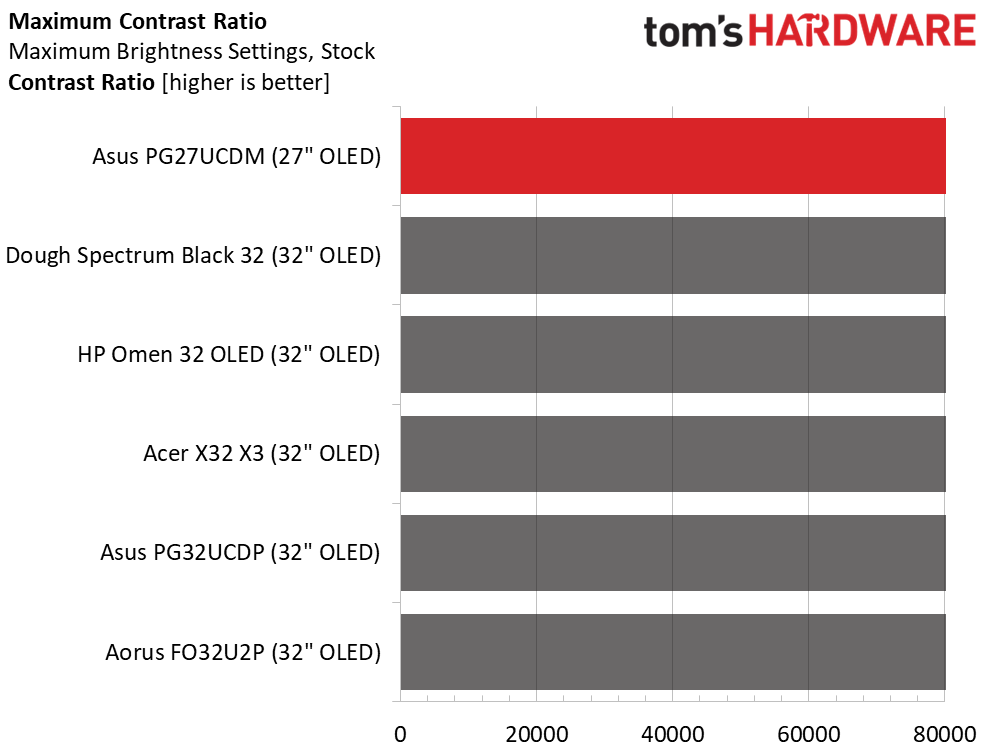
Not all OLEDs have variable brightness available for SDR content, but the PG27UCDM does. I measured a 25% window and got 445 nits for the win. This isn’t a big deal because in practice, 250 nits is plenty for an indoor setting. And for productivity, constant brightness is easier on the eyes. However, variable brightness is great for gaming, video, and HDR. We’ll talk more about that on page five.
After Calibration to 200 nits
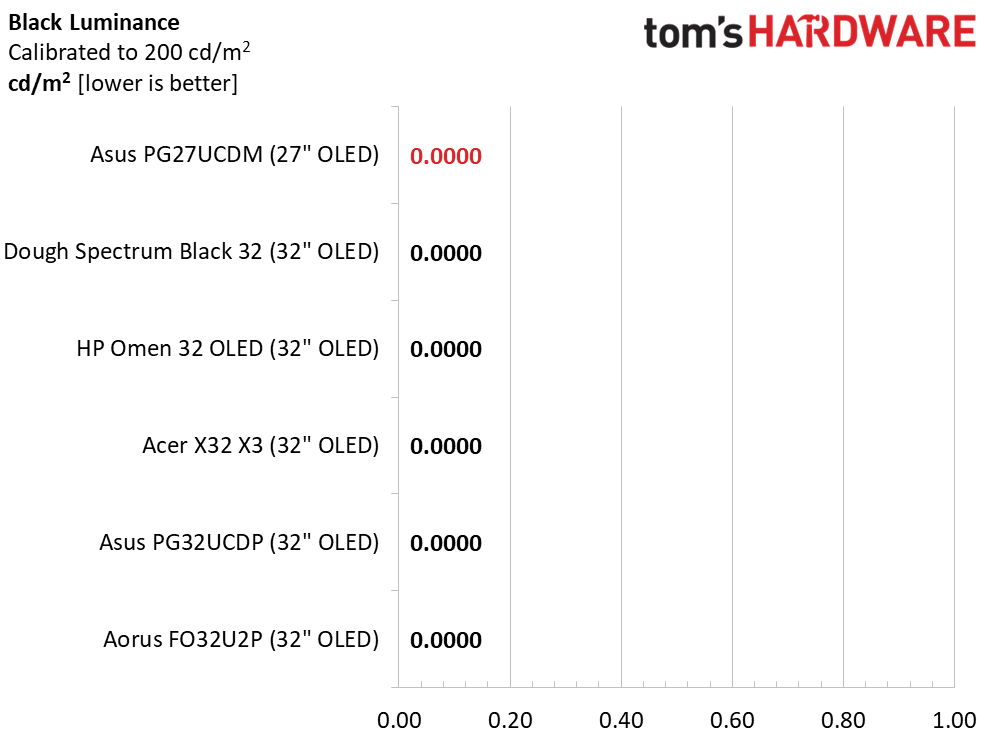
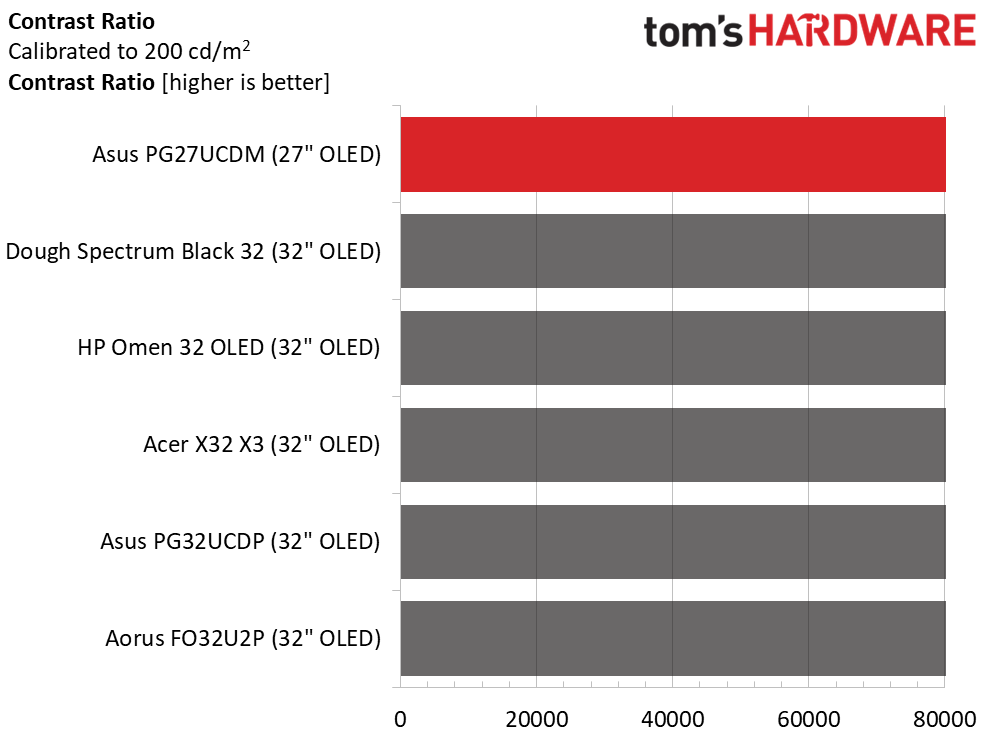
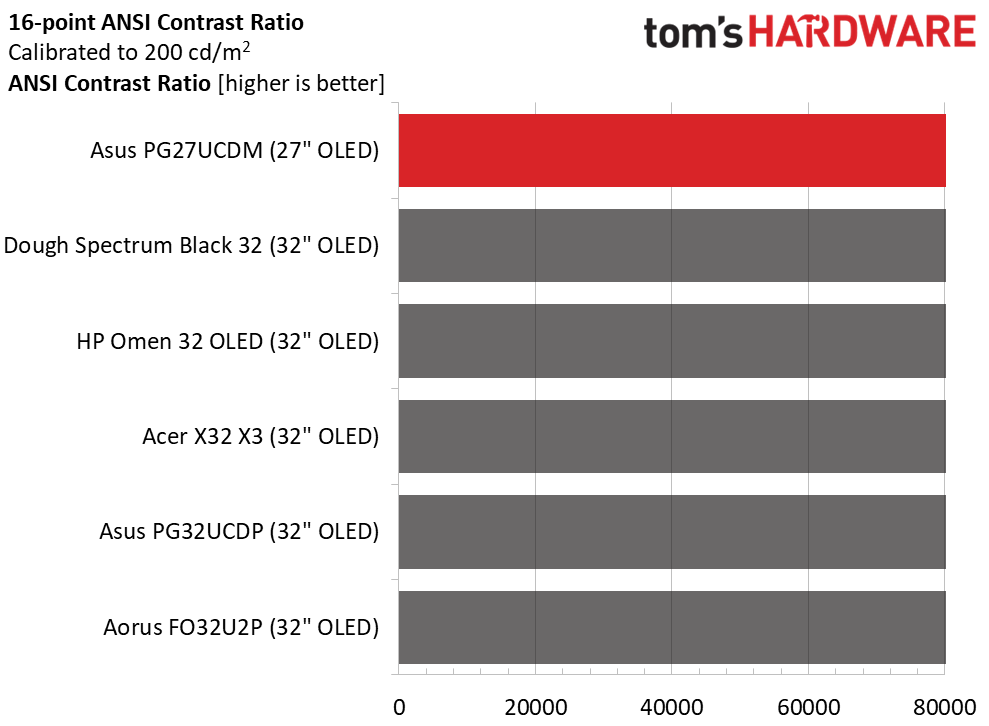
Calibration doesn’t change either black levels or contrast; they remain unmeasurable. For SDR content viewing and testing, I left the PG27UCDM on constant brightness for consistent measurements and for more comfortable productivity. I appreciated the ability to set separate brightness values for each mode, meaning I didn’t have to readjust when switching back and forth. Variable brightness is great for movies and video content in SDR or HDR modes. The ANSI test is also unmeasurable whether constant brightness is on or off.
Test Takeaway: The PG27UCDM has the same peak brightness, infinite black levels, and high contrast as its OLED competitors. It adds a variable brightness option for SDR, which sets it apart from some screens like the HP Omen 32 OLED and Aorus FO32U2P. Ultimately, any level over 250 nits is enough for indoor environments.
MORE: Best Gaming Monitors
MORE: How We Test PC Monitors
MORE: How to Buy a PC Monitor
Get Tom's Hardware's best news and in-depth reviews, straight to your inbox.
Current page: Brightness and Contrast
Prev Page Response, Input Lag, Viewing Angles and Uniformity Next Page Grayscale, Gamma and Color
Christian Eberle is a Contributing Editor for Tom's Hardware US. He's a veteran reviewer of A/V equipment, specializing in monitors. Christian began his obsession with tech when he built his first PC in 1991, a 286 running DOS 3.0 at a blazing 12MHz. In 2006, he undertook training from the Imaging Science Foundation in video calibration and testing and thus started a passion for precise imaging that persists to this day. He is also a professional musician with a degree from the New England Conservatory as a classical bassoonist which he used to good effect as a performer with the West Point Army Band from 1987 to 2013. He enjoys watching movies and listening to high-end audio in his custom-built home theater and can be seen riding trails near his home on a race-ready ICE VTX recumbent trike. Christian enjoys the endless summer in Florida where he lives with his wife and Chihuahua and plays with orchestras around the state.
-
cknobman For gaming this is just a waste of money IMO.Reply
4k at this size does not offer much benefit unless you are a foot or less from the screen. -
Energy96 Reply
I disagree, unless you have cataracts the difference is very noticeable. I have a 27” 1440p and a 32” 4k as well on other machines. The difference is very noticeable even at the usual 2-3 ft from the screen, side by side is even more noticeable.cknobman said:For gaming this is just a waste of money IMO.
4k at this size does not offer much benefit unless you are a foot or less from the screen.
I had a high end 27” 4k IPS ASUS ROG Swift PG27UQ before I picked this monitor up last month and it’s really good. This one is even better and so much more colorful, the blacks are unbelievable. Side by side (currently the old IPS is used as second screen) the difference is ridiculous and that was a $1500+ IPS ROG monitor. Comparatively $1200 was a bargain.
The only minor annoyance is pixel refresher reminder pops up pretty frequently and is annoying when in the middle of playing something. I probably should just disable the reminder. Also the proximity sensor is not sensitive enough. I have often had it go black while I am sitting there playing a game but must have been very still. It does come back instantly if I move though. It would be better if it cross referenced lack of motion with any screen or mouse movement. It should only go black if the screen is also still. Minor things and all can be adjusted or disabled I suppose.
I don’t think a better screen exists in 27” size. -
PrazVT I don't have space for a 32" but I game at 4k, so I did pick this one up. I came from the LG 27" mini led, which was a nice monitor, but still had black crush / blooming issues despite the large # of dimming zones. I love the PG27UCDM so far. Between the feature set and image quality / performance it's just been a joy to use. The only real bug right now is with the proximity sensor. Despite a recent firmware update, the monitor will go dark after the timer even if you're in front of it and you have to wave your hand to get the monitor to come back on. So I have it disabled until they fix that. Otherwise, between the OLED Care features and just me being more mindful of the static content (b/c I use this monitor for productivity during the day) I am generally happy with the burn-in prevention features.Reply
Yes, the monitor is expensive for the size (ie...costs the same as my Sony OLED TV) ..but it is damn nice. -
RTX 2080 Reply
I’ve owned several monitors, including a 27 inch 4K monitor. It does offer a benefit.cknobman said:For gaming this is just a waste of money IMO.
4k at this size does not offer much benefit unless you are a foot or less from the screen. -
lmcnabney HDR10 is not exactly high end. That is where HDR starts. I would have expected HDR600 if not HDR1000 for this price. It is odd that OLED can't do it.Reply -
endocine Reply
Are you guys doing screen scaling or are you 100% default?Energy96 said:I don’t think a better screen exists in 27” size. -
UnforcedERROR Reply
These mean different things. HDR10 is a video standard. HDR600/1000 are specs relating to overall brightness. Having HDR10 is useful for media consumption as it's a fallback from Dolby Vision. HDR10 and Dolby Vision are also starting to be looked at as viable HDR solutions for gaming (which if you've gamed in HDR you know it's a crap shoot for quality).lmcnabney said:HDR10 is not exactly high end. That is where HDR starts. I would have expected HDR600 if not HDR1000 for this price. It is odd that OLED can't do it. -
Energy96 Reply
You are mixing up 2 different things.lmcnabney said:HDR10 is not exactly high end. That is where HDR starts. I would have expected HDR600 if not HDR1000 for this price. It is odd that OLED can't do it.
This OLED is about as bright as they get. -
Energy96 Reply
Are you talking about the windows setting or a game setting?endocine said:Are you guys doing screen scaling or are you 100% default?
Windows is at the usual recommended 150% when connecting a 4k monitor. 100% the text would be extremely small.
In games I always run native 4k scaling. -
lmcnabney Reply
OLED is intrinsically high in contrast. Brightness is not contrast. These panels may just be relatively low NITS.Energy96 said:You are mixing up 2 different things.
This OLED is about as bright as they get.
(pulls technical data on the display)
Yep, this display only does 250 nits across the panel and can get as high as 1000 nits, but only 3% of the display can be lit to attain that number. I suspect this low brightness is related to refresh or is required to lower the deterioration rate.
